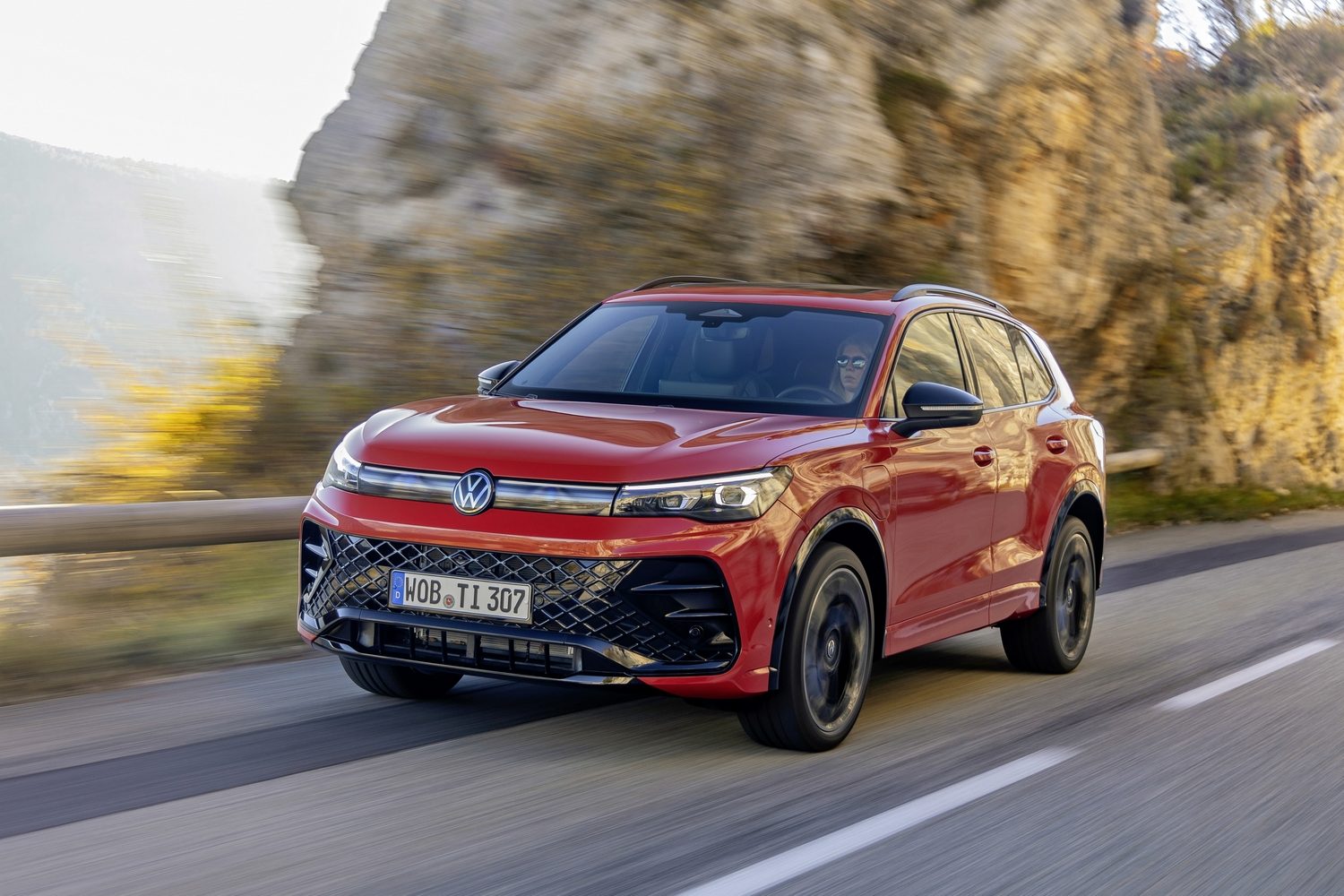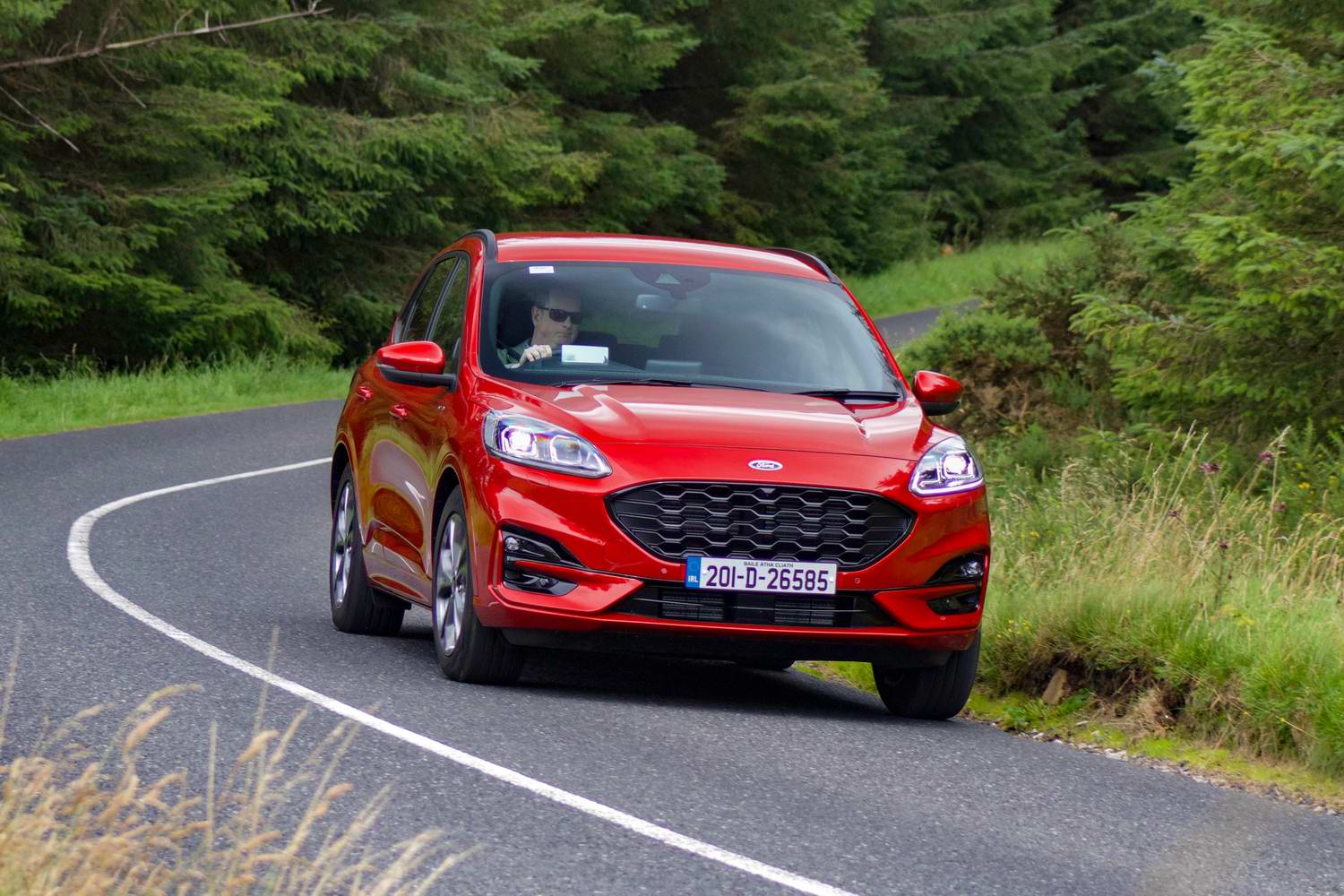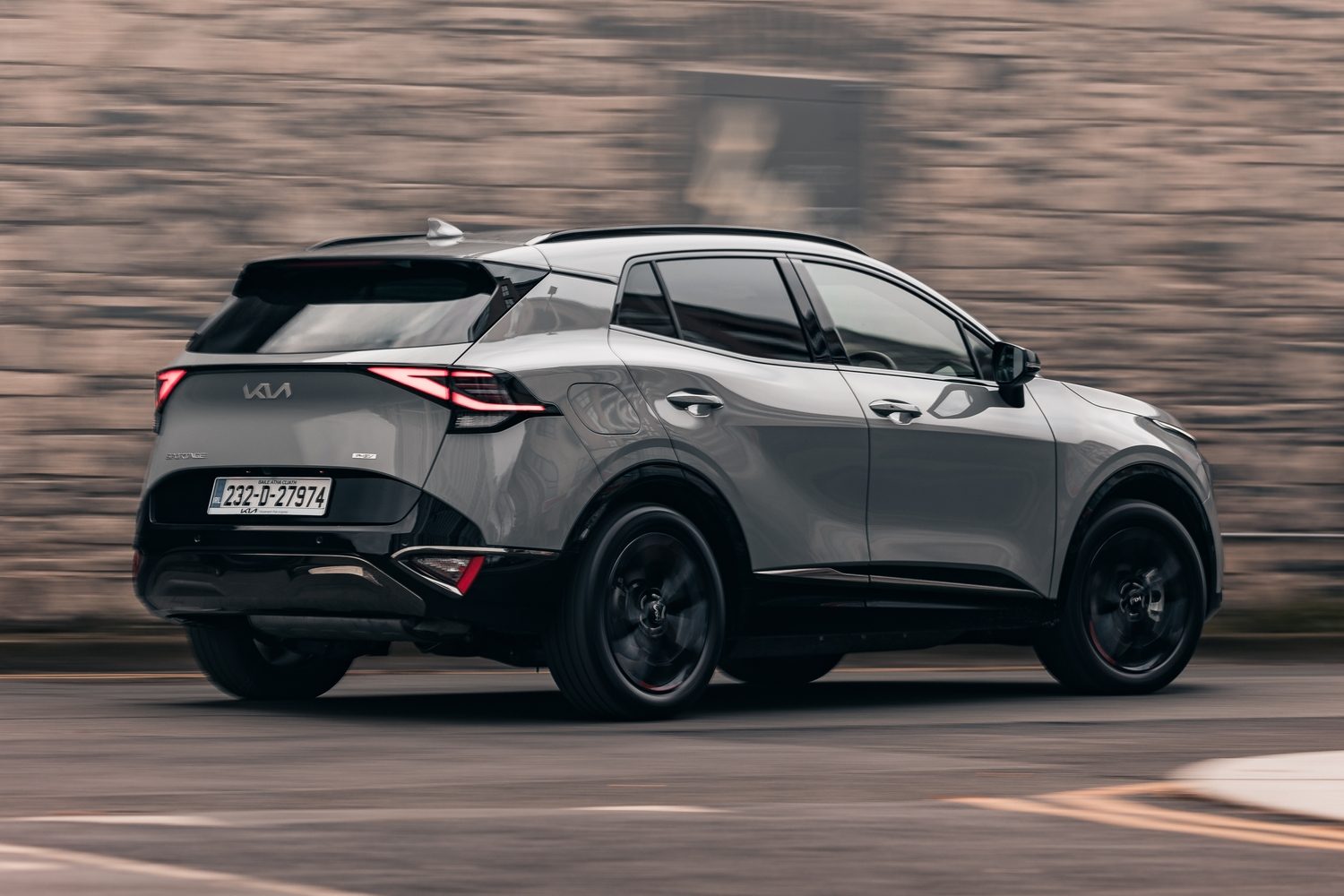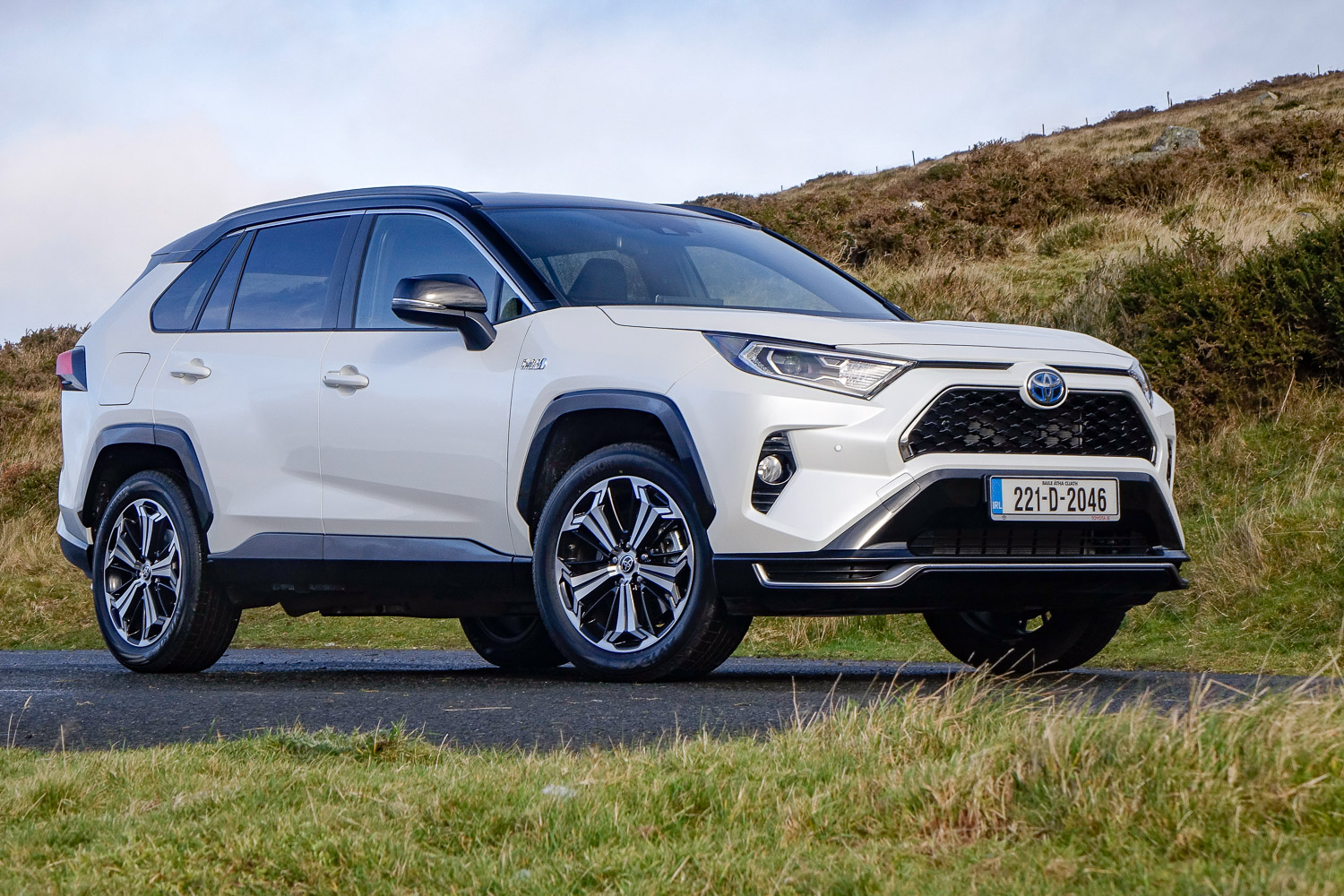Volkswagen has completely renewed the Tiguan, giving it a fresh look and new interior and it has even overhauled the MQB platform that underpins it. There's more space inside, artificial intelligence tech in the dashboard and in this PHEV version a much-upgraded plug-in hybrid system that promises more than 100km of electric range.
In the metal
At a glance, you could be forgiven for thinking that the new VW Tiguan is not the new Tiguan at all, but part of the ID. family. With the styling of the new Tiguan's nose in particular, Volkswagen is clearly trying to make some visual links between its combustion-engined and electric vehicles, and the new Tiguan's slim headlights (optionally fitted with HD Matrix tech, featuring 19,000 separate LED elements each) and the transparent panel that runs between them are certainly very ID-like. The giveaway is the chunky, chrome-laden grille lower down in the Tiguan's 'face' which feeds air to the radiator.
The rest of the new Tiguan's exterior is familiar, with some nice Touareg-like detailing around the rear lights and light bar. Alloy wheels are sized from 17-inch to 20-inch rims depending on specification.
Inside, you'll find more dramatic differences between this Tiguan and the last one. The biggest - in every sense - is the 15-inch touchscreen in the centre of the dash. Borrowed from the ID.7 electric car, this massive screen gets the latest MIB4 software, which Volkswagen has created more or less from the ground up.
It's been a largely successful effort. Any system with this many functions is eventually going to lapse into information overload, but the software is now much more responsive and easier to use, and the menu system is simpler and more logical in its layout. The customisable shortcut keys are helpful, and the fact that the climate controls are 'always on' at the bottom of the screen is good. The touch-sensitive 'slider' controls for volume and cabin heat are as fiddly as ever, but at least they now light up at night. You do wonder, though, if this big, optional, 15-inch screen is entirely necessary, when the standard 12.9-inch version works the same and seems plenty big enough to us.
As the Tiguan's gear selector is now a twist-and-go lever on the steering column, there's tonnes of space for storage, cupholders and both wireless and wired phone charging in the middle of the car. There's also a new addition - a little knurled rotary controller that seems like a slight nod of the modern-day head to the original Golf GTI's golf-ball dimpled gear lever.
This one doesn't control gears, though; it's initially for the stereo volume but press the miniature touchscreen in its centre and it can also be used to select from the car's driving modes and, at the swipe of a finger, the Tiguan's 'Atmospheres.' These Atmospheres are pre-loaded settings for things such as in-cabin ambient lighting (which extends to a backlit panel on the passenger side of the dashboard), the stereo volume and intensity, and the climate control. So, select 'Lounge' if you want cool purple jazz-club lighting and everything set to soft and easy, or Joy if you want it all Barbie-pink and pulsating. A gimmick? Perhaps, but you can see the use of it at times and just don't use it if you don't like it.
Is ChatGPT more useful? Volkswagen is integrating the sometimes-controversial AI technology into the dashboard as part of the 'IDA' voice control assistant. For now, it can only 'know' things up to 2021, and far from being human-like in its responses, the synthesised voice sounds incredibly robotic.
Volkswagen has included it for entertainment and information purposes, rather than as a pure machine-learning tool that gets to know you and your habits. All the data, we are assured, is anonymised and all queries instantly deleted once the response is given. The idea is more about keeping your kids quiet on a long journey (IDA can tell them a story in a chosen genre and style, or give out info on local landmarks), though with incoming software updates it will become more agile in its responses, able to organise impromptu quizzes and the like. Does it make the voice control any better? Maybe, but it still seemed too likely to return a 'I don't have that information' response to us.
There's other high-tech stuff inside the Tiguan. The front seats are borrowed from the larger, more luxurious Volkswagen Touareg and feature an optional massage function, as well as heating and cooling depending on the spec. They're wonderfully comfortable. There's also an advanced parking assistance system, which allows you to get out and complete a manoeuvre from your mobile phone if needed.
More importantly, there's space inside and lots of it. In the back seats, legroom and headroom are exceptionally good (if you have the adjustable rear seats slid fully to the rear) and there's lots of storage space, too. The boot is a little more variable - regular Tiguans get as much as 652 litres of luggage-carrying capacity, depending on where you have the rear seats positioned, but in this e-Hybrid that drops to 490 litres thanks to the need to package the big battery underneath.
Driving it
Speaking of that big hybrid battery, the Tiguan e-Hybrid now gets a 19kWh unit, just as does the updated Golf which goes on sale this summer. That means you should be able to get impressive electric range out of this e-Hybrid model. The previous Tiguan e-Hybrid, which used the old 1.4-litre turbocharged petrol engine and a smaller battery, had an official range of 60km on electric power, and it could usually only be relied upon to provide about 45-50km of that. This new Tiguan e-Hybrid gets the more modern 1.5-litre TSI petrol engine as its mechanical heart, and thanks to that bigger battery Volkswagen is talking of electric ranges of up to 120km on a full charge.
Well, that's the likely official figure - this is still a pre-production vehicle and it's not been officially put through the WLTP test yet - but the more realistic daily figure is a still-impressive 100km. More impressive still is that seems like a reachable goal - on our test drive, starting with a 39 per cent charge in the battery, the Tiguan's dashboard was telling us we still had 42km of electric range left. Given that Volkswagen's research reckons that 99 per cent of all journeys are of less than 100km, this Tiguan e-Hybrid has the potential to be an electric car for 99 per cent of your use - assuming you can keep the battery charged up.
It will charge faster than before too. The old Tiguan e-Hybrid could charge its battery at a measly 3.4kW of AC power. This one will cope with 11kW on a suitable AC connection and, thanks to CCS plug compatibility, can also DC fast-charge at up to 50kW when you're out and about. This means you can top your Tiguan's battery up to 80 per cent in about 25 minutes at a suitable public charger.
As far as long-range economy goes, that's a little hard for us to assess, given the brevity of our test route. It seems likely that lengthy motorway journeys with a discharged high-voltage battery will see you get about 6.0 litres per 100km, or thereabouts, which is reasonable, but we need to assess the Tiguan e-Hybrid at home, on familiar routes, to be certain. Volkswagen claims you can put more than 800km under the Tiguan's wheels without stopping if you start with a fully-charged battery and a full 45-litre fuel tank, but we suspect that will be closer to 700km in real-world conditions.
The 1.5 TSI engine is certainly a better, and smoother, companion for the electric side of things than the old 1.4-litre unit. Yes, it revs up a bit when you accelerate hard, but the noise is kept well enough under control, and it's never too much of an aural assault. Overall performance feels sprightly, and the system deftly manages the switch from one power source to another. This one develops up to 204hp and 350Nm of torque, but there is a more powerful version with 272hp and 400Nm, too.
The Tiguan's weight has gone up, even if at 1,870kg it's hardly the porkiest car in its class. It is some 60mm longer than before, though, and the extra size does make itself felt on tight and twisty roads. The steering is, in typical Volkswagen fashion, nicely weighted and accurate, and once you accept that there's always going to be a good dollop of body lean, the Tiguan clings on to a chosen cornering line.
What it's really good at is cruising. The hybrid system is refined to begin with, and thanks to the changes to the MQB underpinnings (it's now the EQB Evo), the Tiguan is a noticeably comfortable and quiet cruiser. The optional DCC Plus adaptive dampers - which use some clever twin-valve technology to separate out the compression and rebound forces - work well, but we suspect that most people who buy them will only ever really use Comfort mode.
What you get for your money
Volkswagen Ireland hasn't announced pricing for the Tiguan e-Hybrid yet, as it's a model that will arrive later this year. The first new Tiguan models to land here in March will be the diesel versions, with the 2.0-litre 150hp TDI base model costing from €48,095. That pitches the Tiguan at the more expensive end of the family SUV market, but it is very well equipped as standard, with the 12.9-inch touchscreen, climate control, digital instruments, LED headlights, the IDA voice assistant with ChatGPT (which is being rolled out on a phased basis), high-output 45W USB sockets, black roof rails and 17-inch alloy wheels. Standard safety systems include lane change assist, emergency braking, lane departure warning, a rear-view camera and dynamic road sign recognition.
Summary
As you'd expect from Volkswagen, the new Tiguan looks and feels like a spectacularly slick product. The exterior styling is not the company's best work, but the cabin looks terrific, the infotainment now works well, and the car as a whole is hugely spacious. The Tiguan is good to drive, too, and this e-Hybrid has the makings of an impressive, truly flexible part-electric option.
























